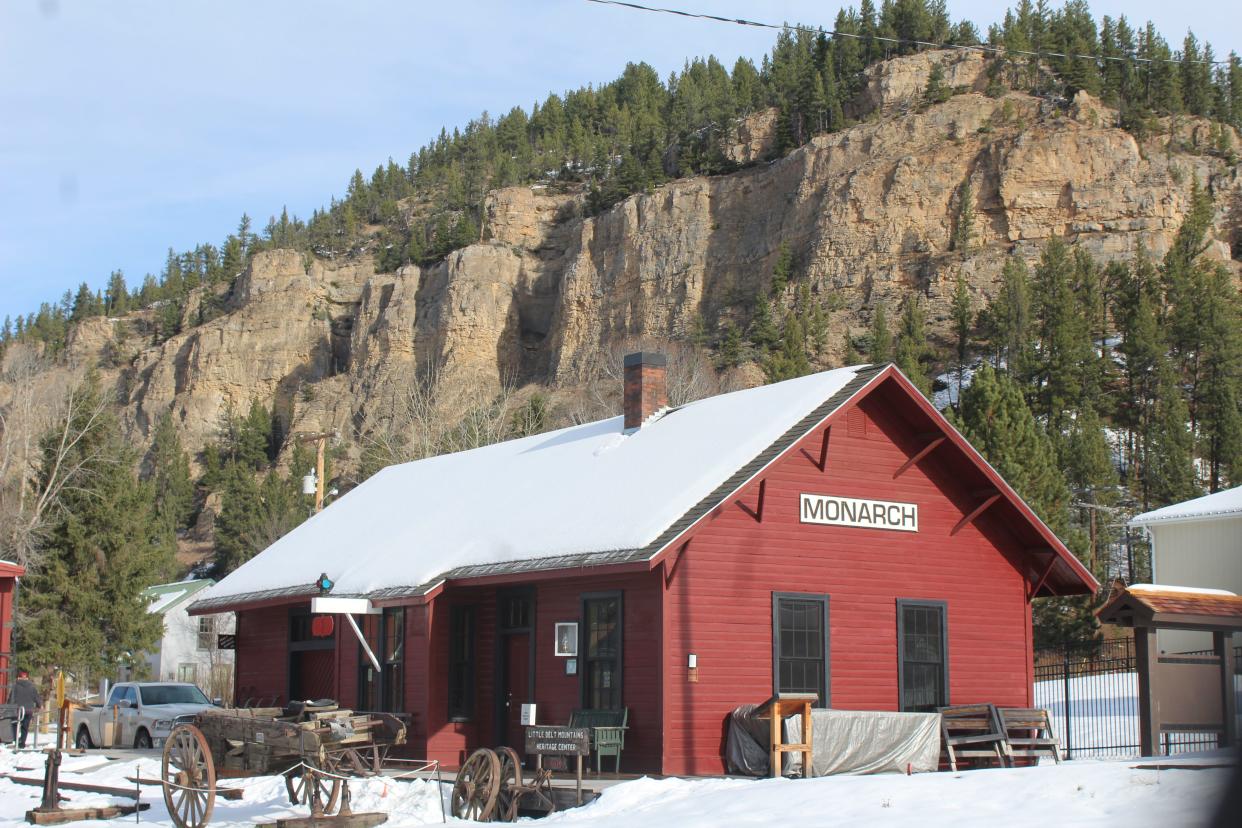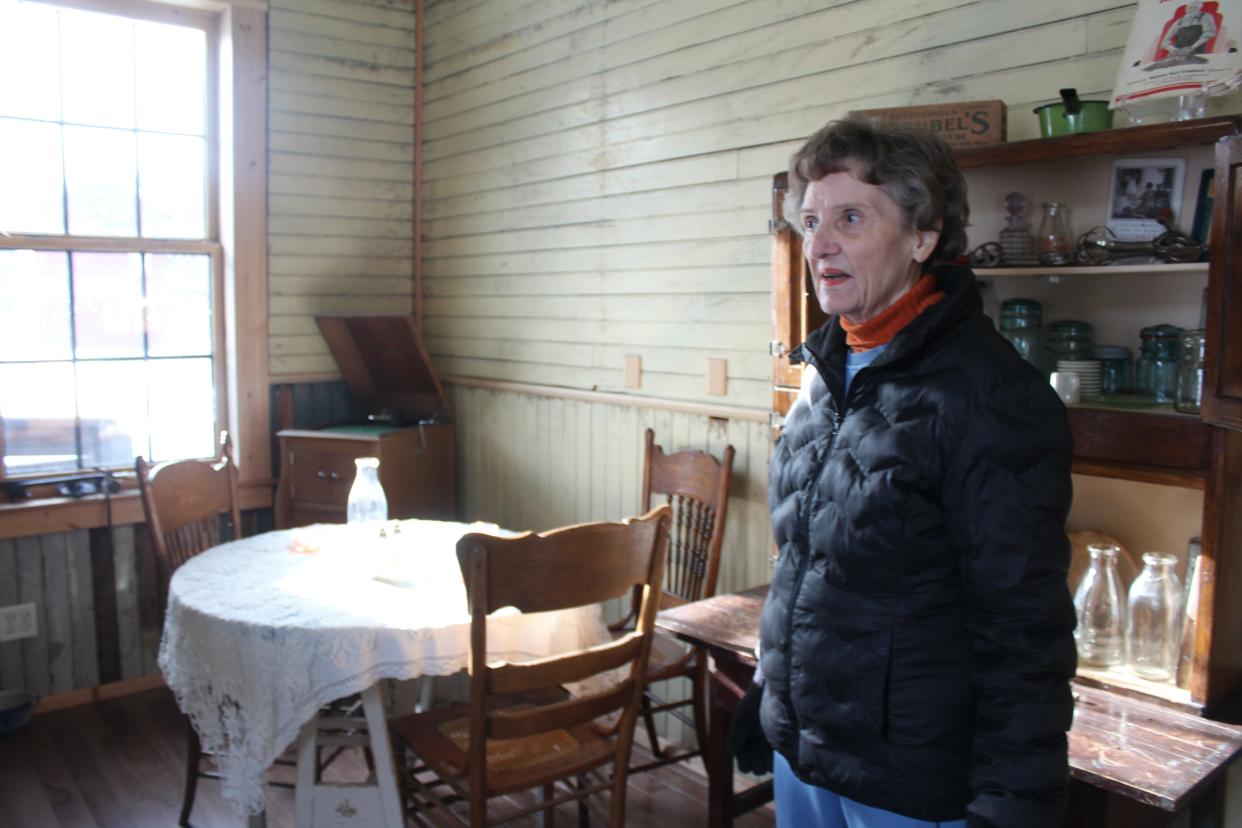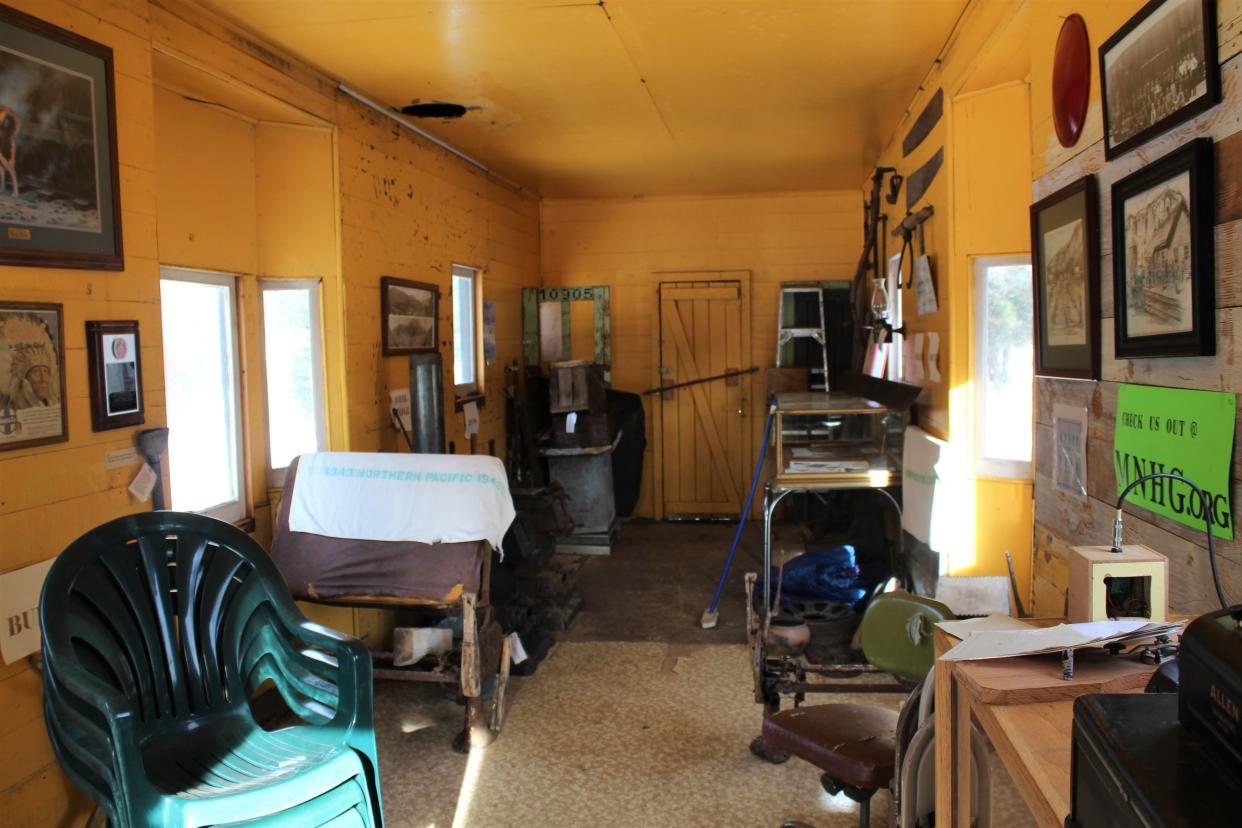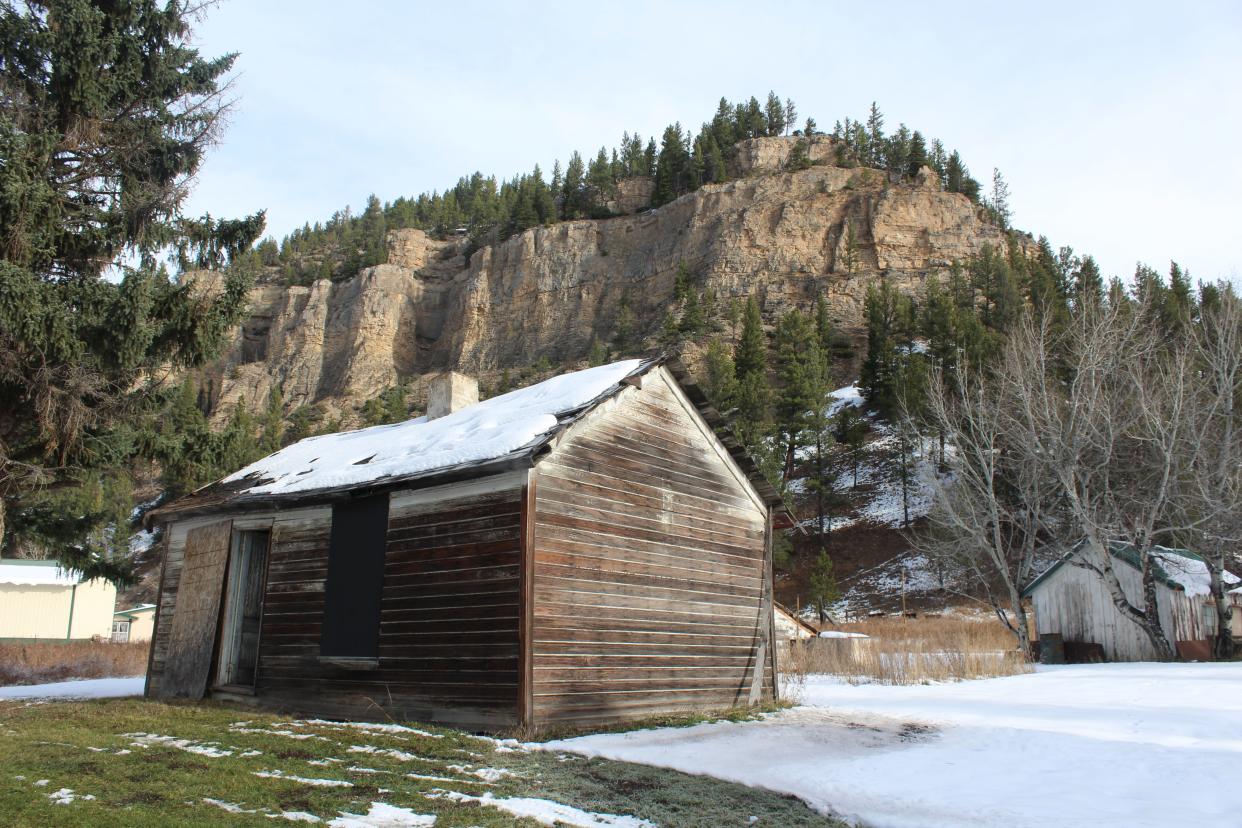New donation means preservation of Monarch train depot will continue
The little town of Monarch lies on the floor of a quartzite canyon that hems in Belt Creek. On a fall day it’s a beautiful drive through the Little Belt Mountains. Pine trees shaded by steep cliffs, a rushing mountain stream and inviting turnoffs that lead to homes and cabins tucked off in the woods that surround U.S. Highway 89.
These days most motorists rush past Monarch on their way over Kings Hill Pass to the Yellowstone Valley or to ski at Showdown. But a century ago Monarch and the mountain corridor that surrounds it was a prolific center of industry and commerce. Silver mines at the camps at Hughesville, Barker and Neihart exhumed a steady supply of valuable ore for processing in Great Falls, and harvests from the surrounding forests filled carloads of timber for the growing communities in the valleys below.
Monarch was never a big town, probably never more than a couple hundred residents. Today fewer than 40 people live there, but in its time Monarch was an economic hub where raw materials harvested from the Little Belt Mountains were collected, assembled, and prepared for shipment to smelters and mills in Great Falls. At the center of all of it was the Great Northern Railroad.

Tracks reached the community 50 miles southeast of Great Falls in 1890, one year after the community’s founding. The Great Northern was the town’s lifeblood. It provided quick and convenient transportation at a time when other transport was measured at the pace of a horse.
“It took a horse and buggy 12-hours to get from Monarch to Great Falls,” said Janet Enloe of the days before the railroad. “You had to rest the horses for two hours at Armington (24 miles east of Great Falls). When the train came through it was a four-hour trip.”
The importance of the arrival of the Great Northern Railroad to the foundation of central Montana’s economy cannot be overstated, but little more than a decade ago the railroad’s legacy in Monarch was at risk of being lost. In 2000, Enloe, her husband Hugh Enloe, Bob Majerus and a handful of other concerned residents of Monarch set out to save what they could.
“We’d seen over the years the decline,” Hugh Enloe said. “Historic buildings up and down the street were being demolished. This (the depot), the section house across the street and a couple of houses upstream were getting to be the last ones around. In 2000, Janet made a concerted effort along with Ellen Sievert (Cascade County Historic Preservation Officer) to try and save this building.”
It all started with the old Great Northern Railroad Depot, a building erected after the original depot burned in 1900 and built to the precise specifications of the railroad’s standardized depot blueprints.
In 2000 the old Monarch train depot was owned by the Montana Department of Transportation (MDOT), which had purchased the building in 1946 from the Great Northern Railroad after the company closed its rail service into the Little Belt Mountains. The MDOT tore out the depot’s interior walls and northern exterior to convert the building into a garage for highway snowplows.
One hundred and ten years after its original construction the old depot was in bad shape. The roof, which still consisted of the building’s original wood shingles, was little more than a sieve and the lower couple of feet of exterior walls had largely rotted away. Still, what had now become the Monarch-Neihart Historic Historical Group — the Enloes, Majerus and a few other concerned folk — took up the challenge.

“We had little support,” Janet Enloe said of the group’s early efforts. “People thought we were crazy. We would never be able to raise the amount of money it would take to restore it, and I couldn’t argue with any of them. It was true, but we just dove in. We had a contractor and architect come in and we asked, where do we start? What do we do first? They said do the roof. So, we got grant money and a lot of donations. We were able to do that the first year.”
That was in 2012. From its beginning, the Monarch-Neihart Historical Group (MNHG) placed its emphasis on authenticity and historical accuracy. As a member of the Great Northern Railway Society, MNHG was able to obtain the original blueprints for the Monarch depot, which was a great asset in restoring the depot to its original standard. This extended down to preserving the original Great Northern green paint that decorated the depot’s interior and having a Helena specialty mill recreate some of the original woodwork that once lined the Monarch depot’s walls.
“The main thing was trying to get the lower walls rebuilt,” Janet Enloe said. “There was a lot of rot. We salvaged all the original materials we could and reused them. While Bob and Hugh were busy fixing, I raised funds and worked with a contractor who was willing to let volunteers do some of the work to stretch the money we had raised. We focused on doing a project each summer that was visible to the public so they could see some progress. The more we did the more money came in and the more motivated we became.”
To replace the building materials lost to time they turned to a reproduction of a 1908 catalogue listing turn-of-the-century housing components down to porches and window moldings in precise detail. By cross referencing the catalogue with original blueprints, the Enloes were able to track down precise details incorporated within the Monarch Depot at the time it was built.
In the decade since the MNHG began its restoration efforts in Monarch the group has also been able to add and restore a Great Northern Railroad caboose built in 1902, then converted into a “drover car” for cattlemen to reside in while riding with herds shipped by rail in the 1960s.

Perhaps the rarest and most unusual structure the MNHG maintains is a standard Great Northern outhouse. The old two stall privy sat next unnoticed next to the depot for decades. Little did the Enloes know that it had some significant historical value.
“We had a Great Northern Railroad buff go through in 2014 and he was all excited because he had written a quarterly pamphlet just on Great Northern privies,” Janet Enloe explained. “He had researched it and interviewed people and he didn’t find one person who had seen one or knew of any in existence. He said that could be the only one still standing.”
Later research discovered a second Great Northern privy that had been moved to a farm three miles outside of Belt. Cascade County may possibly be home to the only two 1920s era Great Northern Railroad privies still in existence.
Janet, Hugh and Joe are now past their 60s and had expected that what important parts of the Great Northern Railroad that remained in Monarch had already been identified and preserved to the best of their abilities. The group’s energy and commitment to historical accuracy has won the MNHG multiple awards from the Great Falls History Museum, the Cascade County Historic Preservation Advisory Commission, and the Montana Historic Preservation Office.
Then, in 2022, a new opportunity arose involving an unidentified run-down shack just to the north of the depot.
“The owner, from the Stober family, said I’ve got a Great Northern building and I’m going to tear it down,” Janet Enloe recalled. “We had no clue what it was. I thought it was a shop for repairs or a warehouse or something. So, we asked him to donate it to us and we would move it off his property.”
In researching the property, Janet came across a booklet published by the Great Northern Railway Society describing section houses built by the railway.
“I was paging through the section house booklet and there it was,” Janet Enloe said. “The dimensions were the same and I got excited. We went over there and checked out where all the windows and doors were there and it matched, so we discovered that he had a section house, and he didn’t know it.”
Section houses were often the first structures built at a location where men were stationed to service the track. Many remote sites had no accommodations for these workers and the need to provide housing and support facilities fell on the Great Northern.
They weren’t fancy. Typically measuring just 16 x 24 feet they contained three rooms: two bedrooms smaller than a modern shipping container with bunk beds shoved against the walls, and a common living and dining area with a stove for heating and cooking. Up to eight men would occupy the section house at any given time. By the time the MNHG discovered Monarch's section house was in bad shape. Still, the active members of the MNHG are approaching the project with the same zeal they did with the depot.
“It sits on a root cellar and the floor’s rotted, so its not safe for walking on,” Janet Enloe said, “but we were able to get to the interior walls and they were covered, and it looks like they’ve been protected because of the covering that’s over them. We might be able to salvage most of that stuff.”
In August 2022 the conservation group was graced by a benefactor with a personal connection to the Monarch area and an interest in preserving its history. The Monarch-Neihart Historical Group has now accepted a $30,000 donation from the Grey Family Foundation of California for the restoration of the Great Northern Railway section house in Monarch. The gift was presented to honor the life of Steve Severance and his lifelong connection to the Monarch-Neihart area in the Little Belt Mountains.

“They have a cabin in Logging Creek,” Janet Enloe explained of the origin of the Grey family’s gift. “The original owner (Mr. Severance) was a dentist in Great Falls, and he was able to get a lease from the Forest Service to build a cabin in 1927. Mr. Severance had three children who all lived out of state in California but who would come back every summer for a week or two and spend it at the cabin on Logging Creek.”
Although the Severance/Grey family never lived full-time in the cabin near Monarch, it was and remains a special place for them filled will nearly a century of memories. After the family’s patriarch, Steve Severance, died unexpectedly his family decided they wanted to do something to honor his memory. It was natural for them to turn toward the place that had meant so much to Steve and his entire family for so many years, from the time he was a small boy.
As with the depot, the MNHG’s first priority is to stabilize the old section house. With the gift from the Grey Family Foundation the Enloes plan to begin replacing the building’s roof next spring but estimate it will take an additional $20,000 to fully restore the structure. Like the depot, the MNHG plans to remain faithful to the Great Northern Railway’s original vison of the building, no matter how humble.
“It won’t be fancy,” Hugh Enloe admitted. “We don’t believe in remodeling. When that’s done it doesn’t look old, and it doesn’t look historic.”
The old section house will eventually be moved from the Stober family’s private property to MNHG property and placed on a new foundation. New windows, doors, and a new floor will come next, with repairs to the walls and ceiling. They hope to add electricity and insulation in the years ahead. Anyone wishing to help fund this restoration or other MNHG projects can send a donation to MNHG, PO Box 924, Monarch, MT 59463.
As for Janet, Hugh and Bob, no matter how hard the work might be they revel in history they’ve uncovered.
“There are more and more stories to be told,” Janet Enloe commented.
This article originally appeared on Great Falls Tribune: Small town activists save century old Montana train station
